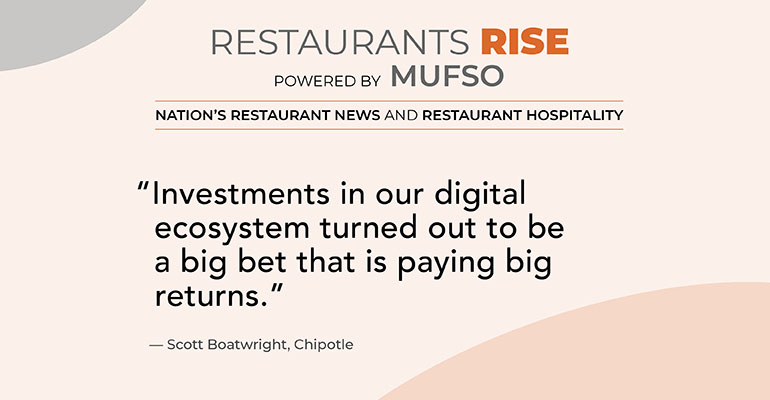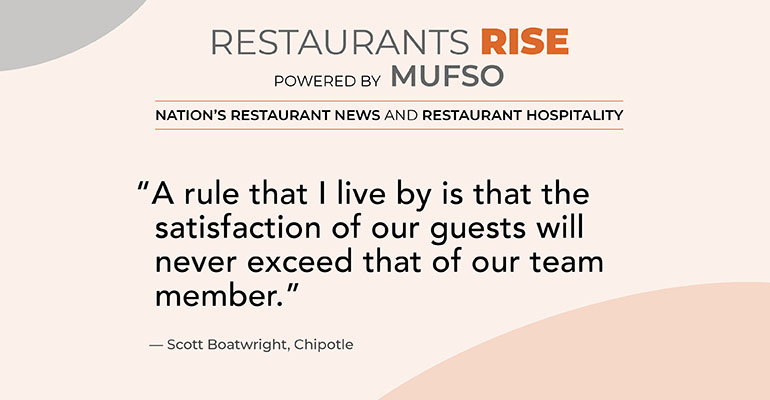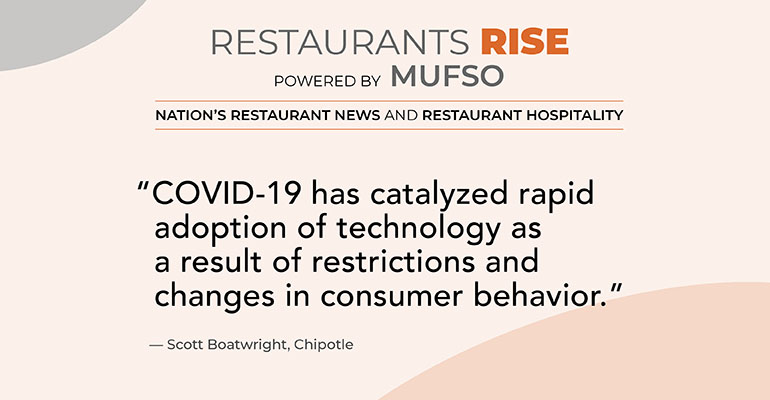New technology has helped restaurants function better during the pandemic. Videoconferencing has helped management stay in touch with each other and new menu items to be tested at a distance, online ordering capability has allowed restaurants to get food to customers where and when they wanted it, electronic readouts have improved order efficiency. Technology also has helped with supply chain and inventory, and, with developments in artificial intelligence, is starting to anticipate restaurants’ needs. But restaurants are, above all else, about people.
“Our industry is still a people business, a business where we rely on people choosing our products, people serving our products and people cooking our food,” Scott Boatwright, chief restaurant officer of Chipotle Mexican Grill, told virtual attendees of Restaurants Rise powered by MUFSO in a presentation titled A Recipe for Success: Tech and Talent.
The presentation was sponsored by DoorDash.
 “The magic of technology is in the interplay of the technology and people,” he said. “It’s how we leverage technology through our organization, not only at Chipotle but with our partners, to deliver the experience.”
“The magic of technology is in the interplay of the technology and people,” he said. “It’s how we leverage technology through our organization, not only at Chipotle but with our partners, to deliver the experience.”
That experience extends beyond customers to employees as well, he said.
“A team member empowered to do their job more precisely, more easily, more [enjoyably] and more consistently as a result of technology is likely more engaged and more available to focus their attention on the needs of the guest,” he said.
That’s particularly true of the company’s Millennial and Gen Z employees, who grew up in a tech-enabled environment and are most comfortable there.
The technology revolution at Chipotle was well underway before the onset of the pandemic, but the change ins consumer needs accelerated it, Boatwright said.
Two years ago, digital sales accounted for 10% of Chipotle’s business. Now it’s nearly 50%.
“COVID-19 has catalyzed rapid adoption of technology as a result of restrictions and changes in consumer behavior,” Boatwright said.
But long before the pandemic, long lines at Chipotle were deterring some customers, many of whom were digital-savvy customers who were not accustomed to waiting for what they wanted.
To help improve the bottleneck in production, Chipotle introduced a second make line to focus on digital orders so the make line in view of customers could focus on them. The first “digital makelines” were installed in 2015, and by 2019 they were in 95% of restaurants.
“We chose to invest in innovation before the business was really there, and as you can imagine that’s never a pain-free process,” Boatwright said. But they knew that “people count on the expediency of the meal as part of the elevated guest experience, and they are unwilling to wait in long lines.”
 Now the business is most decidedly there: Boatwright said that by the end of October, digital channels had already accounted for $1.5 billion in sales so far this year.
Now the business is most decidedly there: Boatwright said that by the end of October, digital channels had already accounted for $1.5 billion in sales so far this year.
“Investments in our digital ecosystem turned out to be a big bet that is paying big returns,” he said. In fact, digital traffic was maintained even as dining rooms reopened and customers once again were eating in the restaurants and getting takeout.
The restaurants themselves had been further updated with mobile-order pickup shelves that removed friction points between guests and cashiers: Guests could pick up their orders contact-free, without even speaking with anybody, and so could third-party delivery drivers.
Searching for more ways to remove friction from the guest experience, Chipotle developed drive-thru-only restaurants, called Chipotlanes. People order ahead and pick up their food at the designated time. The first Chipotlane opened in 2018 and there are now 129 of them, and more than half of new restaurants going forward will be Chipotlanes, Boatwright said.
Meanwhile, Chipotle has been busy overhauling its app to make it easier for guests to order. Now it stores previous orders and interfaces with third-party delivery services.
“You can have your favorite order delivered in just a couple of clicks from our application,” Boatwright said.
The app also has the chain’s loyalty program, Chipotle Rewards, integrated into it, allowing for targeted communication that helps drive trial of new items and reinforces “brand affinity,” he said.
Launched last year, Chipotle Rewards now has 16 million members, he said.
 But a key to customer satisfaction is happy employees, Boatwright said.
But a key to customer satisfaction is happy employees, Boatwright said.
“A rule that I live by is that the satisfaction of our guests will never exceed that of our team members,” he said.
That meant improving those digital makelines, which, despite their name were analog from employees’ perspective: They had to work off of printed chits to fill orders, which was confusing and often let to frustration and errors.
So Chipotle worked with their point-of-sale partners to develop a digital system with screens that “dramatically improved accuracy and timeliness” of the digital makelines, Boatwright said.
So did figuring out just how fast those employees could put orders together. If the orders started coming faster than they could handle them, stress levels went up and order accuracy went down.
“If a system doesn’t have the team member excitement and buy-in, it’s destined to fall short,” Boatwright said.
So Chipotle developed software to measure makeline workers capacity, and to pace orders based on what they could handle.
Similarly, Chipotle didn’t integrate third-party delivery into their operations until they could integrate them into their own POS system companywide, eliminating the need for extra devices that would gum up the works and frustrate employees.
Boatwright said that when making changes in operations, it’s important to keep the interests of guests and team members in mind, as well as the company’s bottom line.
 That’s why Chipotle doesn’t offer quesadillas.
That’s why Chipotle doesn’t offer quesadillas.
“We know [quesadillas are] right for the guest: It’s our most requested item at Chipotle today,” he said. However, it’s not right for employees.
“Its negative effect on throughput outweighs the benefit to the consumer, so we continue to work on it until we get to a solution that works at each level of consideration.”
But there’s good news on that front, he said. “I think we’re close on quesadillas, and I’m imagining some of you are clapping right now.”
Title sponsors for MUFSO include the Coca-Cola Company, PepsiCo Foodservice and Johnsonville Foodservice.
Contact Bret Thorn at [email protected]
Follow him on Twitter: @foodwriterdiary





